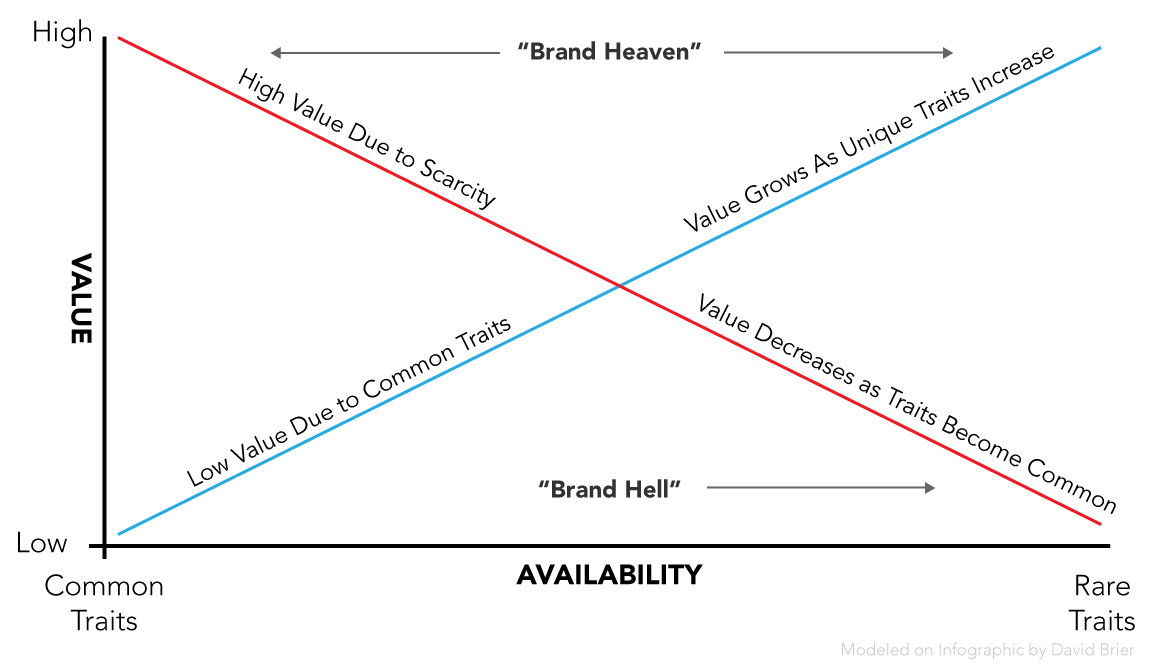
The Top 5 Ways to Boost Ecommerce Brand Value (and ROI)
The higher your brand value, the more valuable your products and services are seen in the eyes of the people who matter the most to your success.
How valuable is your ecommerce brand?
How do you even measure your ecommerce brand value, anyway?
And how do you improve your brand’s value?
Seth Godin put it this way:
A brand is the set of expectations, memories, stories, and relationships that, taken together, account for a consumer’s decision to choose one product or service over another… A brand’s value is merely the sum total of how much extra people will pay, or how often they choose, the expectations, memories, stories and relationships of one brand over the alternatives.
The higher your brand value, the more valuable your products and services are seen in the eyes of the people who matter the most to your success.
Imagine yourself flipping a switch that would shine a spotlight on your brand, draw immediate attention to your website, and send your brand value skyward.
Would you invest a few minutes to find that switch? Would it be time well spent?
The truth is, ecommerce conversion rate optimization (CRO) can be a great way to help boost your brand value. The better you understand your top consumers, the easier it will be to identify and deliver the experience that provides the most value and to steer away from the work that provides little value.

What Is Brand Value?
Brand value is tied to the experience your customers have when they engage with you. It is the value a company earns in the eyes of their customers. Brand value grows as the company’s unique traits and benefits increase.
Why are we talking about brand value? Because CRO is a key part of improving brand value. As you optimize your user experience, you deliver a better more distinctive experience to your visitors, which in turn drives higher brand value.
Why Is Brand Value Important?
Brand value measurements provide feedback on your brand reputation. You know what your company thinks of itself, and you know how you wish to be positioned in the marketplace.
But what’s the reality?
Are your desires for your company mirrored in the minds of consumers? Or are you like every other company promising to be “the best” with “quick delivery” and “amazing customer service”?
The proof is in the pudding.
Brand value measures the depth of the pudding, tastes the flavor, and gives you a thumbs up or thumbs down.
Brand value is like beauty: it’s in the eyes of the beholder. Share on XIn this article, we’ll look at five keys to building brand value and boosting ROI. These five points could open the door to rapid progress for your ecommerce brand.
The Top 5 Ways to Build Your Ecommerce Website’s Brand Value
The Information Age has us all staggering under the burden of information overload.
From email autoresponder sequences anyone can configure, to the rise of bots and artificial intelligence tools readily available to everyone, we’re furiously trying to keep up.
That’s why reducing the areas you need to focus on to ignite brand value from potentially hundreds of tools, measurements, and methods down to the five that make the lion’s share of difference is so important.
You can handle five.
Don’t just read them. If you don’t follow these tips, your competition will.
Here are the five key ways top ecommerce VPs ensure their brands provide value:
1. Give Visitors the Content They Crave
The content on your site is either converting new visitors into buyers, helping current customers buy more, or turning them both away.
You can evaluate your content performance by identifying customer goals and tracking how the site helps your visitors accomplish those goals.
Here are two direct paths to doing that:
- Review, study, and interpret data from your website analytics
- Leverage the knowledge gained by your customer service team
Analytics and customer service feedback are keys to developing a clear process for identifying ineffective content that is costing money in lost sales—so you can revise or eliminate it.
You should also review your path to sales to make sure your category structure matches the way consumers approach your products.
And don’t forget to evaluate your product detail page content. Make sure all the most important and differentiating information is up front and easy to understand.
Ecommerce website #analytics and customer service feedback are keys to identifying ineffective content. Share on XThere are three things visitors to your ecommerce site really want to know:
- What exactly is your product or service good at doing?
- How will that help them?
- Where is the info they need to make the right purchase?
If you fail to provide the answers to those three questions—or you don’t make those answers evident and easily acceptable—your brand value will drop in the eyes of your prospects.
Resource: 3 Keys to Putting Great Content Online
2. Give Visitors an Unforgettable User Experience
Your branded ecommerce website is a major touchpoint that consistently moves consumers closer toward or away from your brand. The catchall term is “user experience” (UX).
If visitors have a bad experience on your site, 90% won’t come back. Not only that, but they’ll leave with a poor estimation of your brand’s value and will be likely to tell others about their experience.
That’s why you can’t afford to provide your best prospects anything less than an excellent interaction with your website. You may not get a second chance to prove your abilities.
Here are three musts for any business committed to delivering world-class UX:
- You must uncover and understand what your current and prospective customers are looking to your site for—what do they want?
- You must track unique purchase indicators and tailor your content to each customer (not as difficult as it sounds).
- You must make sure the site is easy to use, simple to navigate, and representative of your brand.
Those are the goals. Within each are specific steps you can take to achieve them. You can also contact The Good for guidance.
Resource: How a Strong CRO Audit Improves Your Optimization Process
3. Know and Optimize Your Performance Benchmarks
I don’t have to tell you that time is compressed almost beyond belief. 40 years ago, the pundits were predicting we’d be enjoying shorter work days, four-day work weeks, and plenty of time for leisure—thanks to the wonders of technology.
The pundits were wrong.
Consumers are more time-starved than ever before, so if your website take more than three seconds to load, your visitors are going to be leaving in a hurry.
Wondering how quickly your site loads? Test your load speed here: PageSpeed Insights.
Faster (lower) site load times lead to higher conversion rates. Quick load times are particularly vital to the mobile and tablet experience. If you’ve only designed for desktop computers on fast connections, you’re already losing market share to brands that are better prepared for all traffic.
Redesigning a site to milk out a ten percent bump in page load speed is helpful, but in order to see a performance increase of 350% or more (like Bell Helmets and Easton have seen) for all stats leading to revenue, you’ll need to also consider how your pages will look on mobile.
Many companies now serve up two separate versions of their site to accommodate viewers on both standard and mobile-sized screens. However, as long as your site is mobile responsive, you only need to create one website.
Finally, constant optimization leads to consistent improvement. It’s absolutely critical to continually pay attention to site performance and make things better. Set benchmarks for speed and site performance. Identify multi-screen enhancement opportunities.
You wouldn’t plant a garden and expect it to thrive without water. Testing and optimization are the “water” that enables your site to continuously grow in its ability to help customers and increase revenue.
Resource: A Practical Guide to Website Benchmarking for Competitive Analysis
Constant #optimization leads to consistent improvement. Share on X4. Get Serious About Organic Search Positioning
If you don’t show up on the first page of search results, you don’t exist.
Most brands rank highly for their branded terms but are missing out on potential visitors by not showing up for terms consumers use during the research phase of a purchase.
Here’s what you can do:
Make a list of the terms your best prospects use when they’re looking for information on the kinds of products or services you offer—not the “buy” terms, but the “what” terms. Tools like Google Keyword Planner and Keyword Researcher Pro are excellent resources for building the list beyond your own off-the-cuff suggestions.
Here’s what I mean about the difference between “buy” and “what” terms:
“Where can I get a stainless steel double burner camp stove” is a buy term. If you offer that product and describe it accurately for SEO, you’re in the running for ranking high on the search engine results page (SERP) for it—but the competition is stiff. Someone using that search term is very likely ready to make the purchase.
During the research phase, though, the searcher will use terms like “What should I look for when shopping for a camp stove?” That opens up a huge opportunity. By creating content aimed at educating people about camp stove selection, you may be able to capture a considerable amount of traffic.
Will all of them buy from you? Of course not. But they’ll get familiar with your brand and appreciate the help you’ve provided, and some of them will end up becoming customers.
Compare the keywords in your content now with the list of organic keywords researchers are actually using. Look for gaps and opportunities where you can improve, curate, or create content to help your customers and potential customers get answers to their questions.
The search algorithms are trying to help people find what they’re looking for. If you create quality content that answers your best prospects’ questions and helps them make decisions, chances are good you will be ranked high when someone searches for a product in your category.
People rely on brand websites for trusted information from the source. Do everything you can to be that trusted source of information and content for your brand and community
5. Evaluate Your Social Media Strategy
“Brand engagement” or “participating in the conversation,” call it what you will… social media is here to stay.
Social media rule #1: Be authentic.
When things go wrong, mistakes are made, and customers speak out on social media, your brand has to participate actively on both sides of the conversation.
Acknowledge opportunities to better serve customers. Don’t fight them; come along beside them. Never be too proud or ashamed to admit where you could’ve done better.
Social media rule #2: Don’t sell on social media. Engage.
Evaluate your current strategy for serving customers through social media. Are you passively pushing out links, photos, and brand storytelling material, or do you have dedicated brand ambassadors connecting deeply with your customer base and interacting in real time?
Social media rule #3: If you can’t manage a channel properly, don’t be there.
It’s okay to claim your name and post a sticky message directing visitors to your engagement sites, but don’t build a customer portal you’re not going to be able to manage.
Here’s the one question you need to ask:
“Where are my best prospects congregating?”
Focus on building a presence (i.e. active conversations) on those channels and let the rest sit on the back burner until you need them.
Resource: How to Increase Engagement & Conversions with Interactivity
A Brief Example: Kodak
In 1976, 90 percent of all photographic film and 85 percent of all cameras sold in the USA were manufactured by Kodak. In those pre-computer days, Kodak commercials played during the Super Bowl, on Walt Disney’s Wide World of Color, and during breaks between just about every popular TV show you can think of.
Despite gangbuster success, the company filed for Chapter 11 bankruptcy in 2012, and the Kodak brand—despite the still-strong brand recognition—went from first choice to no choice in the mind of their customers.
How could that happen?
Kodak didn’t get blindsided by the digital revolution. Far from it. Kodak developed a digital camera in 1975, but failed to deploy it.
Why?
Management feared a push toward digital would injure the film business—as indeed turned out to be the case. Few people buy camera film today.
That hesitance, however, gave Apple and other soon-to-arise competitors an open door to success with digital photography. Kodak tried to jump back in, but couldn’t find the elbow room in the dog-eat-dog world of digital.
Why do we mention the Kodak case?
Less than 20 years ago, consumers still saw Kodak as an innovator. Their “You press the button and we do the rest” tagline was still true.
Once Kodak failed to deliver on that promise, though—once that button turned digital—the “Kodak moment” quickly faded into history and became a nostalgic phrase bordering on a joke.
Yes, the company is still leveraging that immense brand value created in the glory days to restructure and redefine the mission, but the point is this:
You may judge your company by its intentions, but consumers judge your company by its actions. They want to see that you don’t just make promises, but that you’re keen to follow through on them.
Customers don’t buy your claims (for long); they buy your results.
Resource: Why Your Brand Story is Killing Conversions
Customers don’t buy your claims (for long); they buy your results. Share on XYou Can Build Brand Value by Attending to Those Five Areas
Make sure your brand provides the content your best prospects are looking for. Serve it to them in the way they’re trying to find it. Make it easy to access and navigate.
Mix it up with video content, audio content, white papers, guides, blog posts, hubpages, and other content forms. Leverage user reviews and testimonials. Stick with high-quality photos and descriptive content that differentiates your offers.
Do all of this and your conversion rates will grow, your customers will be happier, and your brand value will increase.
Make sure optimizing user experience is more than just a checkbox on a long list of budget items. Today’s shoppers want everything on demand. If you don’t provide the experience they’re seeking, your brand value will sink, and your customers will find another company to do business with.
Need help? Contact The Good.

About the Author
Jon MacDonald
Jon MacDonald is founder and President of The Good, a digital experience optimization firm that has achieved results for some of the largest companies including Adobe, Nike, Xerox, Verizon, Intel and more. Jon regularly contributes to publications like Entrepreneur and Inc.